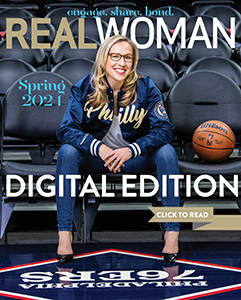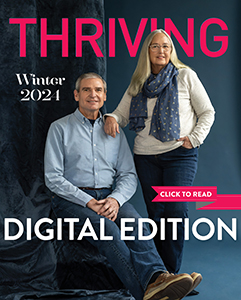On a picture-perfect fall day on the Delaware Canal Towpath, I found myself face-to-dirt about a mile into a run. A new friend’s running origins story—she began on a broken foot—apparently inspired me on a subconscious level. Less than 24 hours after she shared it with me, I tripped on a large walnut lurking beneath freshly fallen leaves. Time slowed to a crawl and the scene played out before me frame-by-frame as if I was spectating my own experience. I saw my left ankle roll out, then felt a stinging snap! while the rest of my body hurtled forward onto my wrists, which became bloodied and bejeweled with gravel, but were otherwise fine.
As I lay writhing on the ground in a state of pain and confusion, a cyclist approached with a smile—but he wasn’t slowing down one bit. I pulled myself together enough to reach out my hand and ask for help getting up. In an SNL Amy Poehler tone of voice, I thought to myself, Really? Were you really going to ride by without stopping to see whether I was okay? Is it common to pass people crawling around on all fours? Really?!? Then I paused and considered that he was probably in his own head the way that I had been in mine when I tripped.
The cyclist, who had no phone, helped me to my feet and went on his way. I laughed at myself as I shuffled the mile back, step by grueling step, alone and also phoneless, hopeful that it was just a sprain. That wish dissipated when I saw my ballooned ankle the next morning. I went to the doctor for x-rays and learned I had broken my left lateral malleolus. That’s near the bottom of the fibula, which fortunately is not the primary weight-bearing bone of the lower leg. They sent me home with a fashionable fiberglass cast—I chose orange for the season—which I’d have for the next 6 weeks.
I wondered if it happened because I wasn’t paying attention. I was deep in thought about a conversation I was planning to have, about coming back with a camera to take scenic photos, and a handful of things other than my run. Perhaps the universe was nudging me to slow… things… down…. A plausible possibility, considering I received a similar message 3 weeks later in the form of a speeding ticket on my way to a cast checkup, when I was cruising along an unusually traffic-free road while singing aloud and in-car dancing to Hozier’s Someone New. Or maybe it was just a freak accident.
In any case, as a fairly active person, I now had no choice but to back off on many of the thing I rely on to relieve stress and keep me grounded. The whole experience would offer me valuable learning opportunities, if only I could remain mindful in experiencing the lows that would undoubtedly come.
I’m acutely aware from life experience that emotional or physical trauma can trigger me to drop into cavernous lows. But over time, I’ve come to know this: We have a choice to view our current circumstances through different lenses. We get to choose our perspective. Yes, it takes conscious effort—sometimes a whole lot. With practice, though, it becomes more natural to respond with compassion, both for yourself and those around you, so that you can integrate a difficult or painful situation into your life experience without allowing yourself to be defined by it.
So, one of the first things I did after the unfortunate turn of the ankle was to give myself permission to experience painful, sad, and negative thoughts. I reminded myself that it was okay to have these feelings and, importantly, to not judge myself for having them.
At times, I felt overwhelmed. On the day of the worst pain, I had a meltdown dealing with an insurance coverage problem. In my three-story old rental home with steep, narrow, winding stairs, daily life activities were treacherous and fatiguing. “Running an errand” became a bad joke when I discovered new perils of everyday mobility (or lack there of), such as navigating parking lots, climbing up and down banister-less stairs, and entering businesses with non-automated, heavy-duty doors that other patrons let slam in my face after they rushed past me.
 Of course there were bright spots, too. Friends, including some great new neighbors, checked in on me and shared their company and food. I found new comfort in writing and contentment in music. With some creativity, I figured out a way to practice yoga with props, including a folding chair, and I went back to classes at my favorite yoga studio where I felt safe and connected with a community of people who’ve come to feel like family. I also had fun using my bright orange cast, tiara, homemade sash, and ribbons of caution tape to make a contest-winning Hallowing costume (the leg injury left me with some extra time on my hands).
Of course there were bright spots, too. Friends, including some great new neighbors, checked in on me and shared their company and food. I found new comfort in writing and contentment in music. With some creativity, I figured out a way to practice yoga with props, including a folding chair, and I went back to classes at my favorite yoga studio where I felt safe and connected with a community of people who’ve come to feel like family. I also had fun using my bright orange cast, tiara, homemade sash, and ribbons of caution tape to make a contest-winning Hallowing costume (the leg injury left me with some extra time on my hands).
In an effort to grow from the experience and avoid slipping down a dark rabbit hole of self-pity and defeatism, I decided to write a couple of lists: things I was grateful for despite my injury, and lessons I learned because of it. Those exercises, as well as writing this article, helped me shift my perspective and get to healing with what felt like a bit of grace.
5 Things I’m Grateful For
Walking and driving: If I had to break a leg, I’m glad it was the left one. Almost immediately, I realized that I could still drive my automatic-transmission car and would not have to depend on others to get me around. Also, because I didn’t break the tibia (the main weight-bearing bone), I didn’t need to completely immobilize my leg.
Everything that didn’t break: I’m grateful I broke only my leg. I went down hard on my wrists, but they came out intact. My knees and elbows were fine, too. As a bonus, I didn’t go sailing into the canal waters next to the path. It could have been so much worse.
Friends: I learned who I can count on to be there for me, to check in on how I’m doing, to offer to hand even when I don’t ask for it.
Yoga: I’m grateful that my yoga practice is always there for me. Yoga is not about how well you can do physical poses. The poses are tools for learning how to be present with what you are experiencing and feeling in your mind and body. An injury that suddenly alters your physical ability provides a valuable opportunity to practice that lesson.
The little things: In the “material things” department, my skinny jeans were still new when I could finally wear them after the cast came off. My warm fuzzy socks went twice the distance because I could only wear one at a time. Alternatively, my right shoes got extra wear compared to their left mates—another excuse to treat myself to new boots after my cast removal.
Plus 5 Essential Lessons
Play smarter and safer. Always run with a friend or a phone. Shuffling that mile back after the break probably didn’t help me.
I am stronger than I thought. When dealing with trauma, you may tap into a wellspring of resilience you didn’t even realize you have. On my long hobble home, endorphins kicked in to elevate my pain tolerance to new heights. I don’t recommend walking on an untreated broken leg, but I admit I felt kind of bad-ass for having done it. I was also motivated to keep moving that day by this contemplation: People around the world have trekked far greater distances and under much direr circumstances.
Mindfulness matters. Yes, daydreaming is important. Allowing your mind to wander nurtures creativity. But it has a time and place. Its counterpart is mindfulness: being present with where you are, what you are doing, and how you are feeling. Being mindful can make a world of difference in your experience of the moment that you are actually in. This is especially true when you’re engaged in a physical activity that involves a risk of injury. Example: If you’re going on a trail run where you may encounter unexpected obstacles, watch your step!
Don’t assume the worst of others. We humans can be oblivious to what’s going on around us if it doesn’t directly involve us. Have you ever accidentally cut someone off in traffic, or not held a door open for someone behind you, simply because you weren’t aware enough to notice them? I have. Next time we see someone else being completely self-absorbed when they could be lending a hand, remember that instead of calling them a jerk under our breath, we have the choice to pause and consider this: Maybe they simply have a lot going on in their life, too. We don’t need to compare and rank our relative hardships.
Stop the negativity and identify the positives. Acknowledging that things sometimes feel crappy doesn’t mean to move permanently into a negative space inside you. There’s a difference between allowing yourself to have and acknowledge your feelings and letting them define who you are. When things don’t go as expected, complaining and blaming yourself or others is an unproductive energy suck that can pull you down into a black hole of misery. That’s no place to be. Finding a lesson from the situation and exercising gratitude can help you pull yourself out of it.
Today, my leg is still fractured, but it was stable enough that the cast was removed. I am moving into another healing phase, with atrophied muscles and tender, swollen tissues that are relearning how to provide support. I am already experiencing new challenges, new pain, and new opportunities for growth. With continued practice, I hope to keep facing them with at least a bit of gratitude, mindfulness, and grace.







